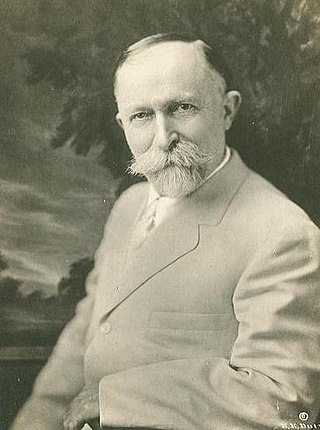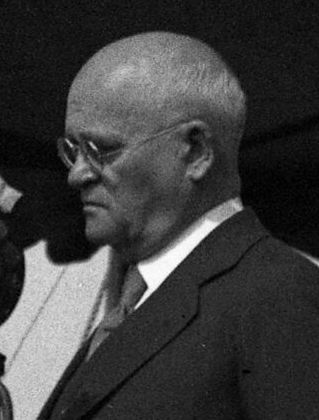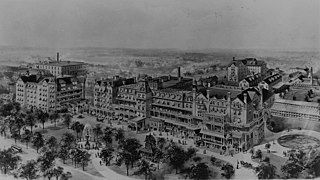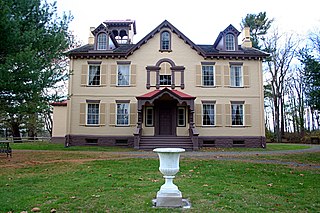
Breakfast cereal is a traditional breakfast food made from processed cereal grains. It is traditionally eaten as part of breakfast, or a snack food, primarily in Western societies.

Corn flakes, or cornflakes, are a breakfast cereal made from toasting flakes of corn (maize). The cereal, originally made with wheat, was created by Will Kellogg in 1894 for patients at the Battle Creek Sanitarium where he worked with his brother John Kellogg who was the superintendent. The breakfast cereal proved popular among the patients and Kellogg subsequently started what became the Kellogg Company to produce corn flakes for the wider public. A patent for the process was granted in 1896, after a legal battle between the two brothers.

John Harvey Kellogg was an American businessman, inventor, and physician who was an advocate of theological modernism and the Progressive Movement. He was the director of the Battle Creek Sanitarium in Battle Creek, Michigan, founded by members of the Seventh-Day Adventist Church. It combined aspects of a European spa, a hydrotherapy institution, a hospital and high-class hotel. Kellogg treated the rich and famous, as well as the poor who could not afford other hospitals. According to Encyclopædia Britannica, his "development of dry breakfast cereals was largely responsible for the creation of the flaked-cereal industry." Popular misconceptions falsely attribute various cultural practices, inventions, and historical events to Kellogg.

The Kellogg Company, doing business as Kellogg's, is an American multinational food manufacturing company headquartered in Battle Creek, Michigan, United States. Kellogg's produces cereal and convenience foods, including crackers and toaster pastries, and markets their products by several well-known brands including Corn Flakes, Rice Krispies, Frosted Flakes, Pringles, Eggo, and Cheez-It. Kellogg's mission statement is "Nourishing families so they can flourish and thrive."

William Keith Kellogg was an American industrialist in food manufacturing, best known as the founder of the Kellogg Company, which produces a wide variety of popular breakfast cereals. He was a member of the Seventh-day Adventist Church and practiced vegetarianism as a dietary principle taught by his church. He also founded the Kellogg Arabian Ranch, which breeds Arabian horses. Kellogg was a philanthropist and started the Kellogg Foundation in 1934 with a $66-million donation.

The Road to Wellville is a 1993 novel by American author T. Coraghessan Boyle. Set in Battle Creek, Michigan, during the early days of breakfast cereals, the story includes a historical fictionalization of John Harvey Kellogg, the inventor of corn flakes.

The Battle Creek Sanitarium was a world-renowned health resort in Battle Creek, Michigan, United States. It started in 1866 on health principles advocated by the Seventh-day Adventist Church and from 1876 to 1943 was managed by Dr. John Harvey Kellogg.

Martin Van Buren National Historic Site is a unit of the United States National Park Service in Columbia County, New York, 1 mile (1.6 km) south of the village of Kinderhook, 125 miles (201 km) north of New York City and 20 miles (32 km) south of Albany. The National Historic Site preserves the Lindenwald estate owned by Martin Van Buren, the eighth president of the United States. Van Buren purchased the 36-room mansion during his presidency in 1839, and it became his home and farm from his leaving office in 1841 until his death in 1862.

The Road to Wellville is a 1994 American comedy drama film adaptation of T. Coraghessan Boyle's novel of the same name, which tells the story of the doctor and clean-living advocate John Harvey Kellogg and his methods employed at the Battle Creek Sanitarium at the beginning of the 20th century. The film was written and directed by Alan Parker.

Battle Creek is a city in the U.S. state of Michigan, in northwest Calhoun County, at the confluence of the Kalamazoo and Battle Creek rivers. It is the principal city of the Battle Creek, Michigan Metropolitan Statistical Area (MSA), which encompasses all of Calhoun County. As of the 2020 census, the city had a total population of 52,731. Nicknamed "Cereal City", it is best known as the home of the Kellogg Company and the founding city of Post Consumer Brands.

The Hart–Dole–Inouye Federal Center, formerly the Battle Creek Federal Center, is a complex of federal buildings located in Battle Creek, Michigan.

The George Rymph House is a historic house located on Albany Post Road in Hyde Park, New York, United States. It is a stone house built during the 1760s by a recent German immigrant. In 1993, it was listed on the National Register of Historic Places.

The Kellogg-Warden House is a single-family house located at 500 North Main Street in Ann Arbor, Michigan. It was listed on the National Register of Historic Places in 1994. It now houses the Washtenaw County Historical Society's Museum on Main Street.

The Adam C. Arnold Block was a commercial building located at 12-14 East State Street in Battle Creek, Michigan. It was listed on the National Register of Historic Places in 1983. It was demolished in 1988.

The Battle Creek City Hall is a governmental building located at 103 East Michigan Avenue in Battle Creek, Michigan. It was listed on the National Register of Historic Places in 1984.

The Van Buren Street Historic District is a cultural historic district located roughly along Van Buren Street from Capital and Cherry Streets to Calhoun Street and North Avenue in Battle Creek, Michigan. It was listed on the National Register of Historic Places in 1996.

The Boys' Club Building, also known as the Youth Building, is a recreational structure located at 115 West Street in Battle Creek, Michigan. It was listed on the National Register of Historic Places in 2004.

The Record Printing and Box Company Building was built as a manufacturing and office building located at 15 Carlyle Street in Battle Creek, Michigan. It was listed on the National Register of Historic Places in 2019. As of 2019, the building was being redeveloped into mixed use commercial space.
The Race Betterment Foundation was a eugenics and racial hygiene organization founded in 1914 at Battle Creek, Michigan by John Harvey Kellogg due to his concerns about what he perceived as "race degeneracy". The foundation supported conferences, publications, and the formation of a eugenics registry in cooperation with the ERO. The foundation also sponsored the Fitter Families Campaign from 1928 to the late 1930s and funded Battle Creek College. The foundation controlled the Battle Creek Food Company, which in turn served as the major source for Kellogg's eugenics programs, conferences, and Battle Creek College. In his will, Kellogg left his entire estate to the foundation. In 1947, the foundation had over $687,000 in assets. By 1967, the foundation's accounts were a mere $492.87. In 1967, the state of Michigan indicted the trustees for squandering the foundation's funds and the foundation closed.

The Phelps Sanitarium, later known as the Battle Creek Sanitarium, was a health care facility located at 197 N. Washington Avenue in Battle Creek, Michigan. It was listed on the National Register of Historic Places in 2001. The building was demolished in 1985, and was removed from the National Register in 1988.






















